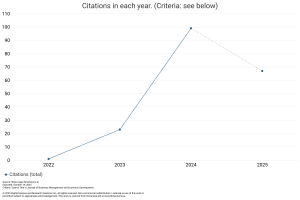Analysis of the Effect of Manufacturing Industry on Indonesia's Economic Growth
DOI:
https://doi.org/10.59653/jbmed.v1i02.151Keywords:
Location Quotient, Shift Share, Sectoral TypologyAbstract
GDP is the amount of value added generated by all business units in a particular country, or is the sum of the value of final goods and services produced by all economic units. GDP at constant prices shows the added value of these goods and services calculated using prices prevailing in a particular year as a basis, which aims to determine economic growth from year to year. The targeted sector is the manufacturing sector of the 17 sectors in Indonesia with 16 subsectors in the manufacturing industry. The calculation of this research uses Location Quotient, Shift Share and Sectoral Typology methods. The results of this study with the LQ method show that the calculation of ADHK GDP has 10 base subsectors and 6 non-base sectors. It is known by Shift Share analysis that the average value of Pj and Dj in all subsectors has a negative value, but there are still subsectors that in some years between 2015-2019 have a positive value in supporting Indonesia's growth. The LQ calculation was developed using the Sectoral Typology method with the results of 10 subsectors with more than enough meaning that the sector is a basic sector with an average LQ> 1 and based on ADHK GDP its growth is slower than ADHB GDP, and its national growth includes fast growth
Downloads
References
Arsyad Lincolin. (1999). Pengantar Perencanaan dan Pembangunan Ekonomi Daerah. BPFE Yogyakarta.
ASEAN. (2020). ASEAN STATISTICAL YEARBOOK 2020. Jakarta: ASEAN Secretariat.
Boediono. (1992). Teori pertumbuhan Ekonomi,Seri Sinopsis Pengantar Ilmu Ekonomi, Edisi 1 Cetakan kelima. BPEE Jogakarta.
Creswell. (2016). Pendekatan Metode Kualitatif, Kuantitatif dan Campuran Edisi 4. Yogyakarta: Pustaka pelajar.
Fadlan, M. A. (2010). Analisis Potensi Pertumbuhan Dipropinsi Lampung 2004-2009. (Analisis Location Quetiont dan Shift Share) , 77.
Fleisher & Bensoussan. (2007). Competitive Positioning Analysis. Chicago: Aldine Publishing Company.
Hari W Richardson. (1973). Elements of regional economics. Midlesex: Penguin Educationarta.
Hendaya, Rachmat. (2003). Aplikasi Metode Location Quotient (LQ) Dalam Penentuan Komoditas Unggulan Nasional. Bogor: Jurnal Peneitian.
Kalzum, R, J. (2018). P-ISSN: 2614-5170, E-ISSN: 2615-1375. Analisis Location Quetient dalam Penentuan Sektor Basis dan Non Basis di Kabupaten Gorontalo, Universitas Gorontao.
Kuncoro, M. (2004). Otonomi dan Pengembangan Daerah: Reformasi, Perencanaan, Strategi dan Peuang. Jakarta: Erlangga.
Maskun, S. (1993). Pembangunan Masyarakat Desa Asas, Kebijaksanaan dan Manajemen. Yogyakarta: Media Widya Mandala.
Prasetyo Soepomo. (1993). Analisis Shift Share, Perkembangan dan Penerapan.
Sugiyono. (2014). Metodeogi Peneitian Manajemen. Bandung: Alfabet.
Sukirno, Sadono. (1994). Pengantar Teori Makro Ekonomi. Jakarta: PT. Raja Grafindo Persada.
Suwardono, dkk. (2002). Teori Ekonomi, Edisi Revisi. Yogyakarta: BPE-UGM.
Tarigan, R. (2007). Ekonomi Regional Teori dan Aplikasi. Jakarta: Penerbit PT.Bumi Aksara.
Todaro, Michael P. (2000). Pembangunan Ekonomi di Dunia Ketiga, Jilid I, Edisi Ketujuh. Jakarta: Erangga.
Tulus Tambunan T H. (2001). Perekonomian Indonesia : Teori dan Temuan
Downloads
Published
How to Cite
Issue
Section
License
Copyright (c) 2023 Putri Putri, Agus Sumanto, Farida Rahmawati

This work is licensed under a Creative Commons Attribution-ShareAlike 4.0 International License.
Authors who publish with this journal agree to the following terms:
- Authors retain copyright and grant the journal right of first publication with the work simultaneously licensed under a Creative Commons Attribution-ShareAlike that allows others to share the work with an acknowledgement of the work's authorship and initial publication in this journal.
- Authors are able to enter into separate, additional contractual arrangements for the non-exclusive distribution of the journal's published version of the work (e.g., post it to an institutional repository or publish it in a book), with an acknowledgement of its initial publication in this journal.
- Authors are permitted and encouraged to post their work online (e.g., in institutional repositories or on their website) prior to and during the submission process, as it can lead to productive exchanges, as well as earlier and greater citation of published work (See The Effect of Open Access).





























